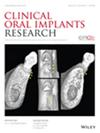Influence of Clinician's Experience on the Accuracy of Dental Implant Placement by Dynamic Computer‐Assisted Surgery Systems: A Systematic Review and Meta‐Analysis
IF 5.3
1区 医学
Q1 DENTISTRY, ORAL SURGERY & MEDICINE
引用次数: 0
Abstract
AimTo synthesize evidence on the effect of clinicians' experience on the accuracy of implants placed using Dynamic Computer‐Assisted Surgery systems (dCAIS).MethodsPubMed, Scopus, EMBASE, and Cochrane Library were searched till April 19, 2025, for research reporting implant accuracy with dCAIS along with the influence of the operator's experience. Clinicians who had placed implants with dCAIS (dCAIS‐Ex) were compared with those without any prior experience with dCAIS (dCAIS‐IEx), irrespective of their experience with implant surgery; clinicians placing implants with dCAIS with or without prior experience in implant surgeries were also compared (IEx vs. I‐InEx). The risk of bias was assessed with ROBINS‐I for in vivo and QUIN tool for in vitro studies. Meta‐analyses were performed to evaluate implant accuracy (coronal, apical, and angular deviations) and operating time.Results4 in vivo and 10 in vitro studies were included. Pooled analysis of in vivo and in vitro studies showed significant differences in angular deviation [SMD = −0.35 (−0.69, −0.01),临床医生的经验对动态计算机辅助手术系统植入牙体准确性的影响:系统回顾和Meta分析
目的综合临床医生经验对动态计算机辅助手术系统(dCAIS)植入物准确性影响的证据。方法检索spubmed、Scopus、EMBASE和Cochrane图书馆,截止到2025年4月19日,研究报告使用dCAIS植入物的准确性以及操作人员经验的影响。将使用dCAIS (dCAIS‐Ex)放置种植体的临床医生与没有使用dCAIS (dCAIS‐IEx)的临床医生进行比较,无论他们是否有种植体手术经验;还比较了有或没有种植体手术经验的使用dCAIS放置种植体的临床医生(IEx vs. I‐InEx)。在体内研究中使用ROBINS‐I评估偏倚风险,体外研究使用QUIN工具评估偏倚风险。Meta分析评估种植体的准确性(冠状、根尖和角度偏差)和手术时间。结果共纳入4项体内研究和10项体外研究。体内和体外研究的汇总分析显示,角偏差有显著差异[SMD = - 0.35 (- 0.69, - 0.01), p = 0.04;SMD = - 0.39 (- 0.62, - 0.17), p = 0.0007],其中dCAIS‐Ex临床医生的偏差低于dCAIS‐IEx临床医生。I‐Ex和I‐IEx临床医生在种植体准确性方面没有统计学差异。不同组间dCAIS手术时间的数据差异很大。结论dCAIS‐Ex与dCAIS‐InEx临床医生放置种植体时,临床医生的经验仅对种植体的角度偏差有显著影响。然而,这种微小的差异可能在临床上无法察觉。需要更多具有高质量和标准化方法的随机临床试验来合成有意义的证据。
本文章由计算机程序翻译,如有差异,请以英文原文为准。
求助全文
约1分钟内获得全文
求助全文
来源期刊

Clinical Oral Implants Research
医学-工程:生物医学
CiteScore
7.70
自引率
11.60%
发文量
149
审稿时长
3 months
期刊介绍:
Clinical Oral Implants Research conveys scientific progress in the field of implant dentistry and its related areas to clinicians, teachers and researchers concerned with the application of this information for the benefit of patients in need of oral implants. The journal addresses itself to clinicians, general practitioners, periodontists, oral and maxillofacial surgeons and prosthodontists, as well as to teachers, academicians and scholars involved in the education of professionals and in the scientific promotion of the field of implant dentistry.
 求助内容:
求助内容: 应助结果提醒方式:
应助结果提醒方式:


